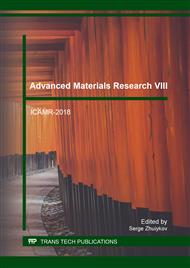p.136
p.140
p.149
p.155
p.160
p.166
p.173
p.178
p.184
Micromechanical Study of the Forged Ti-1023 Titanium Alloy by Micro-Indentation
Abstract:
In order to study the micromechanical behaviour of the forged Ti-1023 titanium alloy, micro-indentation experiments of the forged Ti-1023 titanium alloy were performed with various maximum indentation loads from 500 mN to 4000 mN and various loading speeds from 5.06 mN/s to 51.85 mN/s. Using the experimental data, the non-destructive instrumental approach was applied to indicate the mechanical properties just like the Young’s modulus E, microhardness H, initial yield stress σy and strain hardening exponent n using the P-h curves from the tests. The result showed that the value of the indentation Young’s modulus basically remain unchanged in the range from 110 GPa to 150 GPa and H decreased with the increase of the load, the micro-indentaion plasticity constitutive equations were obtained by using Hookean elastic and power-law plastic stress-strain equations.
Info:
Periodical:
Pages:
160-165
Citation:
Online since:
March 2018
Authors:
Price:
Сopyright:
© 2018 Trans Tech Publications Ltd. All Rights Reserved
Share:
Citation:


